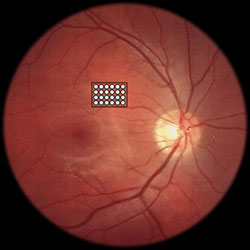
Schematic showing the position of the stimulating array on the retina of the eye.
Our BRIP research team has previously performed proof-of-concept testing patients who were blind from advanced retinitis pigmentosa. Our human testing was performed volunteers who understood that our testing would not provide any direct benefit to them. To be involved in the study, the volunteers had to pass several screening examinations. Multiple discussions were held with each prospective candidate to inform them of the risks of the surgery. The surgeries were performed on the volunteers while they were awake, but locally anesthetized, which allowed them to communicate the visual images that were created directly to the surgical team during the experiment.
We have performed a total of six experiments on humans. These experiments were relatively brief (i.e. they lasted hours) and involved the surgical placement of an electrode array on to the surface of the retina. Very small electrical currents were delivered to the retina. Some of our patients who had been legally-blind for decades were able to see relatively small spots of light (i.e. like a "pea" as if viewed at arm's length) and occasionally were able to distinguish two spots of light from one another and "see" a line.

Pattern of lights ("phosphenes") reported by a patient after stimulation of the retina using an electrode array placed on the surface of the retina.
These early results were encouraging and provided evidence that, in principle, electrical stimulation of the retina may allow us to generate functional vision that would for example, allow a blind patient to identify obstacles and walk unassisted through an unfamiliar or potentially hazardous environment. Subsequent work by other groups (see menu, under "Other Info") has provided additional evidence that blind patients can see basic geometric forms in response to electrical stimulation of the retina.
We are confident that a retinal prosthesis will someday improve the quality-of-life for some visually-impaired patients by providing them with an increased sense of independence. However, there are numerous technical challenges that must be overcome to create highly-detailed vision for blind patients that could conceivably allow them to read the headlines of a newspaper or accurately recognize faces. For example, it is important to determine how to stimulate the delicate retina safely and how to develop appropriate materials to in order to protect the equally delicate electronics of the prosthesis so that it remains functional in the eye for a long period of time. Our research community must learn how to most effectively stimulate the retina with electricity to create the best visual images. For this reason, our BRIP research team is heavily invested in neuroscientific studies to learn more about how the brain normally creates vision and how the brain function is altered in response to blindness.
